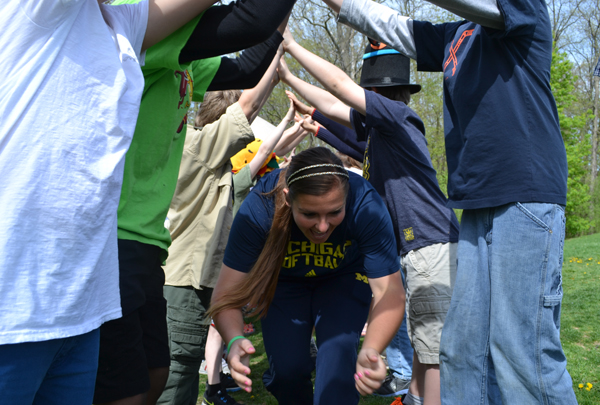• Stone students STRIVE to attend college
By Casey Hans
AAPSNews Service
Ann Arbor’s Stone High School is the proposed site this fall for a countywide cyber-school pilot program that would serve up to 180 high schools students who have either dropped out of school or who are at risk of doing so.
Called WAY Washtenaw, (Widening Advancements for Youth), the year-round secondary program is coordinated through the Washtenaw Intermediate School District and Inclusion U.S., a nonprofit that provides technology and program support for managing student projects.
“We found the kids are out there and they want to come to school,” said WISD Assistant Superintendent Rick Leyshock. “We want them to be in a safe learning environment where they can really develop and learn.”
The Ann Arbor Board of Education heard an overview of the program during a first reading on Wednesday night.
In the project-based program, students will be expected to learn and interact remotely in an online community, reporting to Stone twice each week where they can get help from on-site staff. They also will be in touch regularly online with mentors and project leaders to ensure they are making progress and meeting mandatory high school graduation requirements.
An estimated 600 students have dropped out of high school in Washtenaw County, officials said, prompting the desire and need for such a program. WAY Washtenaw will target students age 16-19 who have dropped out or who have disengaged from traditional high school.
Called “researchers” in the program, students are assigned computers and staff will do home visits to ensure there is an area in which students can work and be successful. Students will remain part of their home school district, so they can participate in sports, music or other extracurriculars at their home high school while enrolled in WAY Washtenaw. Their high school degree will be earned through their home district.
Stone High Principal Sheila Brown and Ann Arbor’s Director of Instructional Technology Monique Uzelac will coordinate the pilot.
Uzelac said a Washtenaw County curriculum team visited other cyber-school programs last December, which generated a lot of excitement and planted the seed for the Washtenaw model. She said 180 student seats were selected as a starting point for the pilot after the team reviewed county dropout rates, talked with area superintendents to gauge interest and estimated how many students might possibly enroll.
Although each district is assigned a number of seats in the program based on their dropout numbers, Leyshock said seats can be used by other districts if slots are not filled.
The program will have 30 part-time mentors, three full-time program leaders and two technicians. It is funded through state per-pupil foundation allowance money, Leyshock explained. Registration for the program is taking place now and will continue through mid-September, when the state’s official count of students takes place to determine the level of funding to school districts.
Parents and students interested in the program can apply online or call for information. They will then have a personal interview and receive full application packets. Once enrolled, staff conducts home visits to ensure there is proper connectivity for the online program and then students are assigned a mentor who will work with them on their projects, which will be reviewed weekly for progress in meeting Michigan high school standards.
Uzelac said plans include training counselors around the county so they can learn about the program and refer appropriate students to it.
Original plans called for piloting WAY Washtenaw in 2011-12, but Leyshock said local superintendents were so enthusiastic that the launch of a pilot was moved to this fall. “I feel there enough legs to this that we will want to scale up big for this the following year,” he added.
Washtenaw’s virtual school project is based on a program called NotSchool (www.inclusiontrust.org/notschool/) in the United Kingdom, which, since 2000, has engaged 5,000 teens who have been out of school in an online learning community. A program looked at locally was Wayne County’s Westwood Cyber School, which has had success since it launched in February 2009.
Glen Taylor is executive director of Inclusion U.S. that partners with districts in Clio in Genesee County and in the Upper Peninsula (www.wayprogram.net.) Taylor’s nonprofit handles the online learning community for WAY projects and will monitor and report upon student progress online.
“We are a nonprofit facilitating programs that are growing and working to create more options for kids,” Taylor explained.
Taylor, the former head of the Westwood Cyber School, said the cyber school approach is gaining popularity around the country including projects in New Jersey, New Mexico and Pennsylvania. Activity in Michigan comes after recently enacted state education reforms boosted the dropout age from 16 to 18 beginning with students graduating in 2016. Taylor said the Michigan Department of Education earmarked $650,000 last fall to address dropout rates and these types of programs.
WAY Washtenaw is one of several high school programs WISD is doing in education partnerships around the county. Other programs either in place or being planned include: an Early College Alliance with Eastern Michigan University, an International Baccalaureate program, New Tech High @ Ardis (a small, academy that uses technology in a project-based environment) and STEM, an academy that will feature a math, science, technology and engineering focus.
The Ann Arbor school board also heard a presentation on the Early College Alliance on Wednesday night.
For more information about the WAY Washtenaw program, visit online or contact: WISD Director of Assessment, Planning & Research Naomi Norman at (734) 994-8100, ext. 1263 or via e-mail.
Casey Hans edits this newsletter for The Ann Arbor Public Schools. E-mail her or call 734-994-2090, internal ext. 51228.



2 Trackbacks / Pingbacks
Comments are closed.